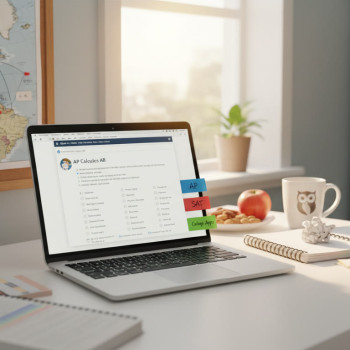Why an Offline AP Prep Kit Is Not Just a Backup — It’s Smart Strategy
Picture this: it’s the night before a big AP exam. Your internet slows to a crawl, devices won’t load the review video, and the online question bank times out. Panic? No — because you prepared differently. An offline AP prep kit gives students and parents the freedom to study anywhere, anytime, without relying on a perfect connection. It’s practical, resilient, and — when built thoughtfully — every bit as effective as online study.

Who Benefits from an Offline Kit?
Offline study is for more than students in rural areas or families with limited data plans. Consider these scenarios where offline prep saves the day:
- Unreliable Wi‑Fi during critical revision weeks.
- Student who learns better with tactile, handwritten notes.
- Long commutes, travel, or study retreats where connection is sparse.
- A household with shared bandwidth where streaming classes are impractical.
- Students who want focused, distraction‑free sessions away from social media.
Core Components of a Powerful Offline AP Prep Kit
Think of the kit as a miniature, portable classroom. The best kits mix content review, active practice, and planning tools. Below are the essentials.
1. A Compact Content Workbook
Create or collect a concise, subject‑by‑subject workbook that covers the course framework and high‑yield topics. It should be:
- Organized by unit or theme (e.g., for AP Biology: Evolution, Cellular Processes, Genetics).
- Two‑page summaries for each major topic: core concepts, key vocabulary, and typical question stems.
- Annotated examples — worked problems for math, sample essays for AP English, annotated graphs for AP Statistics.
2. Printable Practice Tests and Answer Keys
Replication of timed conditions is vital. Include:
- At least 2–3 full practice exams in printed form (multiple choice and free response).
- Separate answer keys with clear scoring rubrics, especially for free‑response sections.
- Detailed scoring sheets so students can track progress and spot recurring weak areas.
3. Targeted Drill Packs
Short, focused drills help build automaticity. For example:
- 30‑minute concept drills (e.g., 20 quantum mechanics matching questions for AP Physics).
- Vocabulary flashcards for languages and social sciences (paper or index cards).
- Graph interpretation packs for AP Environmental Science or AP Statistics.
4. A Practical Study Planner
Structure beats chaos. Provide a semana‑by‑week planner with:
- Timed study blocks (50 minutes study + 10 minute break) mapped to specific content packets.
- Weekly goals and review checkpoints.
- Built‑in mock exam days and reflection prompts.
5. Resource Cards for Quick Reference
Small laminated cards with formulas, thesis templates, or command terms are lifesavers during quick reviews. Put them in a ring so students can flip through during commutes or in spare minutes.
How to Assemble the Kit — Step by Step
Building the kit is half the learning. The process itself teaches prioritization and active recall.
Step 1: Audit Syllabus and Prioritize
Check the AP course framework and list every major unit. Rank units by your current confidence level — focus first on high‑weight topics that you’re least comfortable with.
Step 2: Gather or Create Materials
If you already use textbooks or class handouts, harvest the most concise summaries. Otherwise, write short unit pages (one to two pages) that distill the core. Keep language student‑friendly and add one example problem per concept.
Step 3: Print and Organize
Bind the materials by unit. Use tabs, colored paper, or a simple three‑ring binder. Keep practice tests in a separate envelope so timed exams feel distinct from daily drills.
Step 4: Build Review Routines
Decide which drills you’ll do daily vs weekly. For example, use flashcards 5–10 minutes every day and a practice section on weekends. The planner should reflect your exam date and back‑count study milestones from that day.
Study Strategies That Work Offline
Offline tools shine when paired with high-quality study habits. Below are practical techniques you can implement immediately.
Active Recall: The Single Most Effective Habit
Instead of re-reading, test yourself. Read a one‑page summary, close the page, and write everything you remember for five minutes. Compare to the summary and mark the gaps. Do this regularly and watch retention improve dramatically.
Spaced Repetition with Paper Flashcards
Use the classic Leitner system: boxes labeled Daily, Twice Weekly, Weekly, and Monthly. Move cards forward/back depending on recall success. This low‑tech system equals many digital spaced repetition apps — without the need for internet.
Simulate Test Conditions
Schedule practice exams with a quiet room, a timer, and no phones. Practicing under realistic conditions reduces anxiety and builds pacing skills.
Peer Review and Study Circles
Form small, in‑person study groups to trade timed essays or practice multiple choice sections. Giving and receiving feedback improves understanding and communication skills.
Sample Kit Contents Table (One Student, Single Subject)
| Item | Purpose | How To Use |
|---|---|---|
| 2 Full Practice Exams (Printed) | Pacing and full‑length practice under timed conditions | Take one every 2–3 weeks, grade with rubric, log scores |
| 6 Unit Summaries (1–2 pages each) | Rapid content review | Read, then do 10 min active recall; correct with summary |
| Flashcards (100–200 cards) | Vocabulary and key concept drilling | Daily 10–15 minute Leitner practice |
| 10 Targeted Drill Packs | Practice of frequently tested skills | Short daily drills, 20–30 minutes each |
| Study Planner and Progress Log | Accountability and habit tracking | Fill daily; reflect weekly |
| Rubrics and Sample Answers | Calibrate scoring for free response | Grade blind samples, then compare to sample answers |
Time Management: Building a Realistic Offline Schedule
Time is the currency of exam prep. An offline kit is only helpful when paired with a realistic schedule. Here’s a flexible blueprint you can adapt.
- 12 Weeks Out: Weekly full practice test or timed section; establish baseline scores.
- 8 Weeks Out: Two units per week; daily 30–60 minute active recall sessions; weekly drill pack.
- 4 Weeks Out: Alternate full practice tests with intensive review weeks; boost timed free‑response practice.
- Final Week: Light review, quick flashcard sessions, and two short simulated tests (one with full timing, one for pacing checkpoints).
How Parents Can Support Offline AP Prep
Parents are key partners. Support doesn’t mean teaching content — it means helping create conditions for success.
- Help establish a distraction‑free study space stocked with supplies (printer paper, pens, highlighters, index cards).
- Encourage routine: regular sleep, healthy meals, and scheduled study blocks.
- Be a test reader: assist in timing a practice test and help record scores for discussion afterward.
- Provide emotional support: celebrate small wins and help reframe setbacks as growth opportunities.
Common Pitfalls and How to Avoid Them
Even with the best kit, students can lose steam or study inefficiently. Watch for these traps:
- Passive re‑reading: combat by swapping to active recall and self‑quizzing.
- Overdoing full tests early: conserve full tests for baseline and regular checkpoints, not daily practice.
- Lack of feedback on free response: use provided rubrics or swap essays with a tutor or peer for scoring.
- Inflexible schedules: be honest about time available and adjust blocks realistically.
When to Bring in a Tutor — Even with an Offline Kit
Sometimes offline materials raise questions that need targeted explanation. That’s where expert guidance accelerates progress. Personalized tutors can:
- Diagnose misunderstandings from practice exam patterns.
- Create targeted problem sets you can print and work on offline.
- Provide scoring feedback on free response and model improved responses.
If you’re considering help, look for tutors who offer one‑on‑one guidance, tailored study plans, and the ability to create printable materials. For example, Sparkl’s personalized tutoring pairs expert tutors with AI‑driven insights to craft focused, printable study packs and one‑on‑one coaching that fits naturally with an offline kit.
Examples: Offline Activities Tailored to Specific AP Subjects
Below are subject‑specific examples you can adapt to your kit.
AP Biology
- Foldable diagrams of cell organelles and pathways (handmade with index cards).
- Evolution case study packets: short passages with comprehension questions and data interpretation tasks.
AP Calculus
- Formula and theorem cards, then 15–20 problem drill packets separated by topic (limits, derivatives, integrals).
- Show stepwise solutions in separate answer booklets so students can practice then check work.
AP English Language and Composition
- Rhetorical device index cards and short passages to practice analysis in 15‑minute timed writes.
- Thesis templates and sample outlines for common essay prompts.
AP World History / AP US History
- Timeline cards for major eras; practice DBQ packet with source excerpts and scaffolding questions.
- Scoring rubric cheatsheet for long essays and DBQs.
Measuring Progress: Simple Metrics That Matter
Quantitative tracking keeps motivation high. Use a progress log that captures:
- Practice test scores, by section and overall.
- Time spent on topic vs. score change to find high‑leverage activities.
- Free response rubric scores and qualitative notes on recurring weaknesses.
An Offline Kit On a Budget
Good news: effective offline kits don’t have to be expensive. Prioritize printouts, a sturdy binder, index cards, and a couple of decent pens/highlighters. Many teachers will share printable practice problems and rubrics; reuse classroom handouts smartly. If printing costs are a concern, print double‑sided and prioritize essentials like practice tests and unit summaries.

Bringing It Together: A Weekly Offline Routine Example
Here’s a sample week for a student balancing school and AP prep. Adjust the time blocks to fit your schedule.
- Monday: 40 minutes — Unit summary + active recall; 10 minutes — flashcards.
- Tuesday: 50 minutes — Targeted drill pack; 10 minutes — reflection and planner update.
- Wednesday: 40 minutes — Free response practice (timed 25–40 min); grade with rubric.
- Thursday: 30 minutes — Concept review and flashcards; 20 minutes — peer review or tutor feedback (if available).
- Friday: 50 minutes — Mixed problem set under timed conditions.
- Saturday: 2 hours — Longer deep‑dive into weakest unit, then review mistakes.
- Sunday: 1 hour — Light review and planning for the next week.
Final Thoughts: Confidence Beyond Connectivity
Preparing for AP exams in limited internet scenarios is an opportunity to build strong habits — active recall, sensible pacing, and thoughtful review. An offline AP prep kit is more than a backup plan; it’s a portable, resilient study ecosystem that empowers students to study consistently, efficiently, and with less stress.
And when you need that extra edge, pairing your offline kit with focused, personalized tutoring — like one‑on‑one guidance from Sparkl that offers tailored study plans and AI-informed strategies — can transform hard work into high‑impact learning. The goal isn’t to replace classroom learning or digital tools, but to give students a reliable, confidence‑boosting system that works no matter the signal strength.
Quick Starter Checklist
- Binders: Unit summaries and practice tests.
- Flashcards: 100–200 cards in a Leitner system.
- Two printed full practice exams and answer rubrics.
- Daily planner and progress log.
- Targeted drill packs and sample answers.
- Contact for occasional tutor review for free‑response scoring.
Ready to Start?
Begin small: print one unit summary and create a 10‑card flashcard deck tonight. Test yourself tomorrow for five minutes. Build momentum with small wins, keep the kit organized, and let it grow with your needs. Offline prep isn’t old‑fashioned; it’s deliberate, durable, and remarkably effective. You’ll be amazed how much confident, focused study can do — no Wi‑Fi required.




















No Comments
Leave a comment Cancel